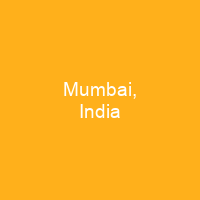Mumbai is the capital city of the Indian state of Maharashtra. As of 2018, Mumbai is the second-most populous city in the country after Delhi. It has the highest number of millionaires and billionaires among all cities in India. It is home to three UNESCO World Heritage Sites: the Elephanta Caves, Chhatrapati Shivaji Maharaj Terminus and the city’s distinctive ensemble of Victorian and Art Deco buildings.
About Mumbai, India in brief

After the English. gained possession of the city in 17th century, the Portuguese name was Bombay Ali Muhammad Khan de Ahmedi, or Mirat Ali Khan de Mirat, or revenue minister of the province, in the Mirat-mediwan or revenue province of Gujarat. It was also known as Bombay bɒmˈbeɪ, the official name until 1995, and Bombaim in the 17th and 18th centuries. In 2008, Mumbai was named an alpha world city, and is one of the world’s top ten centres of commerce in terms of global financial flow, generating 6.16% of India’s GDP, and accounting for 25% of industrial output, 70% of maritime trade in India, and 70% of capital transactions to India’s economy. Mumbai was reshaped by the Hornby Vellard project, which undertook reclamation of the area between the seven islands from the sea in the mid-18th century. Along with construction of major roads and railways, the reclamation project, completed in 1845, transformed Bombay into a major seaport on the Arabian Sea. During the early 20th century it became a strong base for the Indian independence movement. Upon India’s independence in 1947 the city was incorporated into Bombay State. It became the financial, commercial and the entertainment capital of India. The centre of the Mumbai Metropolitan Region, the sixth most populous metropolitan area in the World with a population of over 23 million.
You want to know more about Mumbai, India?
This page is based on the article Mumbai, India published in Wikipedia (as of Dec. 29, 2020) and was automatically summarized using artificial intelligence.







